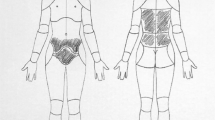Abstract
The aim of this study was to investigate sensitivity and specificity of self-administrated tests aimed at pain provocation of posterior and/or anterior pelvis pain and to investigate pain intensity during and after palpation of the symphysis. A total of 175 women participated in the study, 100 pregnant women with and 25 pregnant women without lumbopelvic back pain and 50 non-pregnant women. Standard pain provocation tests were compared with self assessed tests. All women were asked to estimate pain during and after palpation of the symphysis. For posterior pelvic pain, the self-test of P4 and Bridging test had the highest sensitivity of 0.90 versus 0.97 and specificity of 0.92 and 0.87. Highest sensitivity for self-test for anterior pelvic pain was pulling a mat 0.85. Palpation of symphysis was painful and persistency of pain was the longest among women who fulfilled the criteria for symphyseal pain. There were overall significant differences between the groups concerning intensity and persistency of pain (P < 0.001). Our results indicate that pregnant women can perform a screening by provocation of posterior pelvic pain by self-tests with the new P4 self-test and the Bridging test. Palpation of the symphysis is painful and should only be used as a complement to history taking, pain drawing and pulling a MAT-test.






Similar content being viewed by others

References
Albert H, Godskesen M, Westergaard J (2000) Evaluation of clinical tests used in classification procedures in pregnancy-related pelvic joint pain. Eur Spine J 9:161–166
Albert H, Godskesen M, Westergaard J (2001) Prognosis in four syndromes of pregnancy-related pelvic pain. Acta Obstet Gynecol Scand 80:505–510
Albert HB, Godskesen M, Westergaard JG (2002) Incidence of four syndromes of pregnancy-related pelvic joint pain. Spine 27:2831–2834
Brynhildsen J, Hansson A, Persson A, Hammar M (1998) Follow-up of patients with low back pain during pregnancy. Obstet Gynecol 91:182–186
Cook C, Massa L, Harm-Ernandes I, Segneri R, Adcock J, Kennedy C, Figuers C (2007) Interrater reliability and diagnostic accuracy of pelvic girdle pain classification. J Manipulative Physiol Ther 30:252–258
Gutke A, Ostgaard HC, Oberg B (2006) Pelvic girdle pain and lumbar pain in pregnancy: a cohort study of the consequences in terms of health and functioning. Spine 31:E149–E155
Gutke A, Ostgaard HC, Oberg B (2008) Predicting persistent pregnancy-related low back pain. Spine 33:E386–E393
Hansen A, Jensen DV, Larsen EC, Wilken-Jensen C, Kaae BE, Frolich S, Thomsen HS, Hansen TM (2005) Postpartum pelvic pain––the “pelvic joint syndrome”: a follow-up study with special reference to diagnostic methods. Acta Obstet Gynecol Scand 84:170–176
Hansen A, Jensen DV, Wormslev M, Minck H, Johansen S, Larsen EC, Wilken-Jensen C, Davidsen M, Hansen TM (1999) Symptom-giving pelvic girdle relaxation in pregnancy. II: symptoms and clinical signs. Acta Obstet Gynecol Scand 78:111–115
Huskisson EC (1974) Measurement of pain. Lancet 2:1127–1131
Kristiansson P, Svardsudd K, von Schoultz B (1996) Serum relaxin, symphyseal pain, and back pain during pregnancy. Am J Obstet Gynecol 175:1342–1347
Laslett M, Young SB, Aprill CN, McDonald B (2003) Diagnosing painful sacroiliac joints: a validity study of a McKenzie evaluation and sacroiliac provocation tests. Aust J Physiother 49:89–97
Mens JM, Vleeming A, Stoeckart R, Stam HJ, Snijders CJ (1996) Understanding peripartum pelvic pain. Implications of a patient survey. Spine 21:1363–1369 discussion 1369–1370
Mogren IM (2006) BMI, pain and hyper-mobility are determinants of long-term outcome for women with low back pain and pelvic pain during pregnancy. Eur Spine J 15:1–10
Nilsson-Wikmar L, Holm K, Oijerstedt R, Harms-Ringdahl K (2005) Effect of three different physical therapy treatments on pain and activity in pregnant women with pelvic girdle pain: a randomized clinical trial with 3, 6, and 12 months follow-up postpartum. Spine 30:850–856
Noren L, Ostgaard S, Johansson G, Ostgaard HC (2002) Lumbar back and posterior pelvic pain during pregnancy: a 3-year follow-up. Eur Spine J 11:267–271
Ostgaard HC, Roos-Hansson E, Zetherstrom G (1996) Regression of back and posterior pelvic pain after pregnancy. Spine 21:2777–2780
Ostgaard HC, Zetherstrom G, Roos-Hansson E (1994) The posterior pelvic pain provocation test in pregnant women. Eur Spine J 3:258–260
Ostgaard HC, Zetherstrom G, Roos-Hansson E, Svanberg B (1994) Reduction of back and posterior pelvic pain in pregnancy. Spine 19:894–900
Ransford A, Cairns D, Mooney V (1976) The pain drawing as an aid to the psychological evaluation of patients with low-back pain. Spine 1:127–134
Rost CC, Jacqueline J, Kaiser A, Verhagen AP, Koes BW (2006) Prognosis of women with pelvic pain during pregnancy: a long-term follow-up study. Acta Obstet Gynecol Scand 85:771–777
Sturesson B, Uden G, Uden A (1997) Pain pattern in pregnancy and “catching” of the leg in pregnant women with posterior pelvic pain. Spine 22:1880–1883
To WW, Wong MW (2003) Factors associated with back pain symptoms in pregnancy and the persistence of pain 2 years after pregnancy. Acta Obstet Gynecol Scand 82:1086–1091
Turgut F, Turgut M, Cetinsahin M (1998) A prospective study of persistent back pain after pregnancy. Eur J Obstet Gynecol Reprod Biol 80:45–48
Vleeming A, Albert HB, Ostgaard HC, Sturesson B, Stuge B (2008) European guidelines for the diagnosis and treatment of pelvic girdle pain. Eur Spine J 17:794–819
Author information
Authors and Affiliations
Corresponding author
Rights and permissions
About this article
Cite this article
Fagevik Olsén, M., Gutke, A., Elden, H. et al. Self-administered tests as a screening procedure for pregnancy-related pelvic girdle pain. Eur Spine J 18, 1121–1129 (2009). https://doi.org/10.1007/s00586-009-0948-2
Received:
Revised:
Accepted:
Published:
Issue Date:
DOI: https://doi.org/10.1007/s00586-009-0948-2



